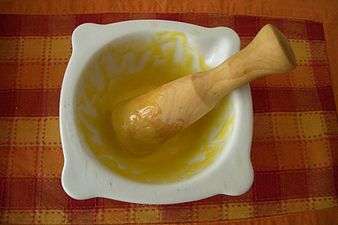Aioli


Aioli or aïoli (/aɪˈoʊli/ or /eɪˈoʊli/; Provençal Occitan: alhòli [aˈʎɔli] or aiòli [aˈjɔli]; Catalan: allioli [ˌaʎiˈɔɫi]) is a Mediterranean sauce made of garlic and olive oil; in some regions other emulsifiers such as egg are used. The names mean "garlic and oil" in Catalan and Provençal. It is particularly associated with the cuisines of the Mediterranean coasts of Spain (Valencia, Catalonia, the Balearic Islands, Murcia and eastern Andalusia), France (Provence) and Italy (Liguria). Current versions of the French-Provençal sauce are typically closer to a garlic mayonnaise, incorporating egg yolks and lemon juice, whereas the original French Provencal and Spanish Catalan versions are without egg yolk and have considerably more garlic. This gives the sauce a pastier texture, while making it considerably more laborious to make as the emulsion is much harder to stabilize.[1][2][3][4] There are many variations, such as adding lemon juice or other seasonings. In France it can include mustard.[5][6] It is usually served at room temperature.
Aioli is, like mayonnaise, an emulsion or suspension of small globules of oil and oil-soluble compounds in water and water-soluble compounds. In Spain, purists consider that the absence of egg is what distinguishes aioli from mayonnaise; however, this is not the case in France and other countries where egg and egg yolk can be used as an emulsifier and is generally used in making aioli today. Using only garlic as an emulsifier requires it to be thoroughly crushed and for oil to be added drop by drop so that the aioli is not "cut" by excess oil.
Since the late 1980s, it has become fashionable to call all flavored mayonnaises "aioli", with flavorings such as saffron or chili.[7] However, purists insist that "flavored mayonnaise can contain garlic, but true aioli contains no seasoning but garlic".[8]
Word
The word is a compound of the words meaning "garlic" and "oil".
The English spelling comes from the French aïoli, which itself comes from Occitan. The spelling in Occitan may be alhòli, following the classical norm, or aiòli, following the Mistralian norm.[9] In Catalan, it is spelled allioli (pronounced [ˌaʎiˈɔɫi]). In southeastern Spain, it is called ajoaceite or ajiaceite, whereas in the rest of Spain, the Catalan term is more common.
Basic recipe
Garlic is crushed in a mortar and pestle and emulsified with egg yolks, salt, and olive oil. Today, aioli is often made in a food processor or blender, but traditionalists object that this does not give the same result.[4]
Serving
In Malta, arjoli or ajjoli is commonly made with the addition of either crushed galletti or tomato.
In Occitan cuisine, aioli is typically served with seafood, fish soup, and croutons, in a dish called merluça amb alhòli.
In the Occitan Valleys of Italy it is served with potatoes[10] boiled with salt and bay laurel.
In Provence, aioli or, more formally, le grand aïoli, aioli garni, or aïoli monstre is a dish consisting of various boiled vegetables (usually carrots, potatoes, artichokes, and green beans), poached fish (normally soaked salt cod), snails, canned tuna, other seafood, and boiled eggs, all served with aioli. This dish is often served during the festivities on the feast days of the patron saint of Provençal villages and towns. It is traditional to serve it with snails for Christmas Eve and with cod on Ash Wednesday.[4] Aïoli is so strongly associated with Provence that when the poet Frédéric Mistral started a regionalist, Provençal-language, newspaper in 1891, he called it L'Aiòli.[2][11]
In Spain, allioli is often served with arròs a banda from Alicante, with grilled lamb, grilled vegetables and arròs negre, and comes in other varieties such as allioli de codony (allioli with boiled quince, not the preserve) or allioli with boiled pear.[5] Other commonly used vegetables are beets, fennel, celery, zucchini, cauliflower, chick peas, and raw tomato.[4][6]
See also
- Garlic sauce
- Agliata
- Dipping sauce
- Mujdei, a Romanian garlic sauce
- Skordalia, a Greek garlic sauce
- Toum, an Arabic garlic sauce
References
- ↑ J.-B. Reboul, La Cuisinière Provençale 1910 (1st edition); 1989 (25th edition), p. 88
- 1 2 Robert Courtine, The Hundred Glories of French Cooking (tr. Derek Coldman), 1973, p. 140
- ↑ Henri Philippon, Cuisine de Provence, 1977 (2nd ed), p. 20
- 1 2 3 4 Mireille Johnston, The Cuisine of the Sun, 1976; Johnston gives one recipe without extra flavorings (p. 75) and one with mustard (p. 229)
- 1 2 Prosper Montagné, Larousse Gastronomique (1938, tr. 1961), s.v.
- 1 2 Olney, Richard (1994). Lulu's Provençal table : the exuberant food and wine from Domaine Tempier Vineyard. New York: HarperCollins. pp. 124–5. ISBN 0-06-016922-2.
- ↑ Google ngrams
- ↑ David Tanis, A Platter of Figs and Other Recipes, ISBN 1579653464, 2008, p. 102
- ↑ cf. Occitan writing systems
- ↑ "La cucina occitana (area cuneese)" (in Italian). Archived from the original on July 23, 2011. Retrieved 2009-04-11.
- ↑ Julian Wright, The Regionalist Movement in France 1890-1914: Jean Charles-Brun and French Political Thought, ISBN 0199264880, p. 47-48 and passim
External links
-
 Media related to Aioli at Wikimedia Commons
Media related to Aioli at Wikimedia Commons